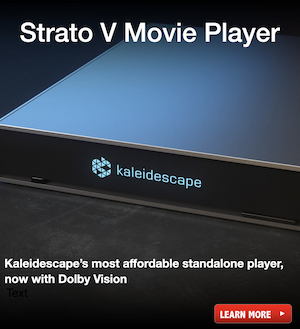(May 1, 2024) Over the last year, we've learned several things about Trinnov's WaveForming technology. First and foremost, it works and works amazingly well. Trinnov spent 2023 showcasing WaveForming in demo rooms at various AV shows, and the results were spectacular. But – yes, there's always a but! – Trinnov's demo rooms to date have been loaded with exceedingly complex speaker arrays and subwoofers needing to be positioned on both horizontal and vertical planes. Toss in complexities in setup processes, and WaveForming has taken on the appearance of a groundbreaking, drool-worthy technology that only the most elite home theaters and home theater installers can handle.
Of course, the name Trinnov and the word "elite" go hand in hand. They're inseparable. But one must realize that there are radically different levels within the world of elite, high-end theaters. There are those "elite" theaters that cost $60,000 and are of average size, and those that dwarf that budget by a million or more. In the case of Trinnov, its WaveForming demo rooms have errored toward the latter, featuring amazing speaker technologies and sub layouts that most home theater enthusiasts either couldn't accommodate or afford.
Recently, Trinnov knocked the 'setup intimidation factor' down several notches by launching a much-welcomed design tool that optimizes a room layout for WaveForming duties. While this tool certainly helps to eliminate a big stumbling block, the issue of needing exceedingly complex subwoofer arrays remained... until now.
We now have two versions of WaveForming. There's "Planar WaveForming," which requires subs positioned both vertically and horizontally in the front and back of a room – yes, this is the version of WaveForming that was launched 18 months ago. And there's "Cylindrical WaveForming," a new, less restrictive approach that's suitable for specific types of rooms and applications. With Cylindrical WaveForming, subwoofers aren't required to be lifted off the ground but rather distributed along the width of the room, both at the front and the back of the listening areas.
This new approach, says Trinnov, is proof of Trinnov’s intention to provide realistic guidance as to what can be expected from the latest technologies, rather than falsely pretending signal processing can solve everything. In other words, it's begun the process of setting expectations for what owners and installers can expect based on installation parameters. It also highlights the flexibility and adaptability of WaveForming and Trinnov technologies across widely varied applications.
In practice, Trinnov says Cylindrical WaveForming leverages the natural wave propagation of the low frequencies in a room, ultimately forming an optimal wavefront using a line array of subwoofers placed below the screen and distributed along the width of the room. When controlled by its WaveForming algorithm, these subs produce a "well-controlled cylindrical wave" that reduces the reflections against a room's front and side walls, while rear-positioned subwoofers block reflections from the back wall. It significantly reduces standing waves, though over a smaller area compared to Planar WaveForming.
While a lack of subwoofers operating in the vertical plane – off the floor – hampers a system's ability to control vertical axial room modes, Cylindrical WaveForming retains other benefits such as width and length room mode control over the entire room and significant decay reduction in the listening area. Trinnov says the ideal room for this type of WaveForming either features a highly absorbent low-frequency ceiling, or an open ceiling. It's also best deployed in smaller rooms with single rows of seating, and, in every case, Trinnov strongly advises against placing the listener's head at the halfway point of the ceiling’s height.
In general, Cylindrical WaveForming follows the same horizontal subwoofer placement guidelines as Planar WaveForming. Its minimum requirements are limited to four subwoofers in total (two on each side of the room), with subwoofers placed on the floor and specified with increased output capabilities. Trinnov says Cylindrical WaveForming maintains most of WaveForming's benefits, but it can't fully control vertical room modes, which is why it is recommended for rooms with high ceilings and/or absorptive treatment for low frequencies. Users should also expect improved seat-to-seat consistency for a larger area compared to a conventional setup, but not across multiple rows (especially if there’s a significant amount of reflexions against the ceiling).
And as an added bit of flexibility, Trinnov says Waveforming also supports hybrid layouts where a line array of subwoofers is positioned at the front of a room and a planar array resides at the rear. For example, you might find a line array of five subwoofers at the front and a planar array of four subwoofers at the rear.
To experience this new implementation of WaveForming, High-End Munich attendees are invited to make an appointment in Atrium 3.1, room C112. The room is made specially for the show and accommodates 18 people for each demo session. It will feature a Perlisten loudspeaker and subwoofer system driven by an Altitude32 processor; all speakers will be powered by an Amplitude16 and an Amplitude8.
For more information about HIGH END Munich, click here.
Related Reading:
- Making It Simple: Trinnov Releases Design Tool to Optimize Room Layout for WaveForming Technology
- Trinnov Unleashes Pressurization, the Latest Add-On to Its Waveforming Technology
- New Trinnov Altitude Processors Begin Shipping with HDMI 2.1 Boards, Upgrades For Existing Customers Ship Soon
- Trinnov Blows Minds, Wows Ears Showcasing Its Incredible 24 Subwoofer Demo Room with Waveforming Technology at CEDIA 2023









